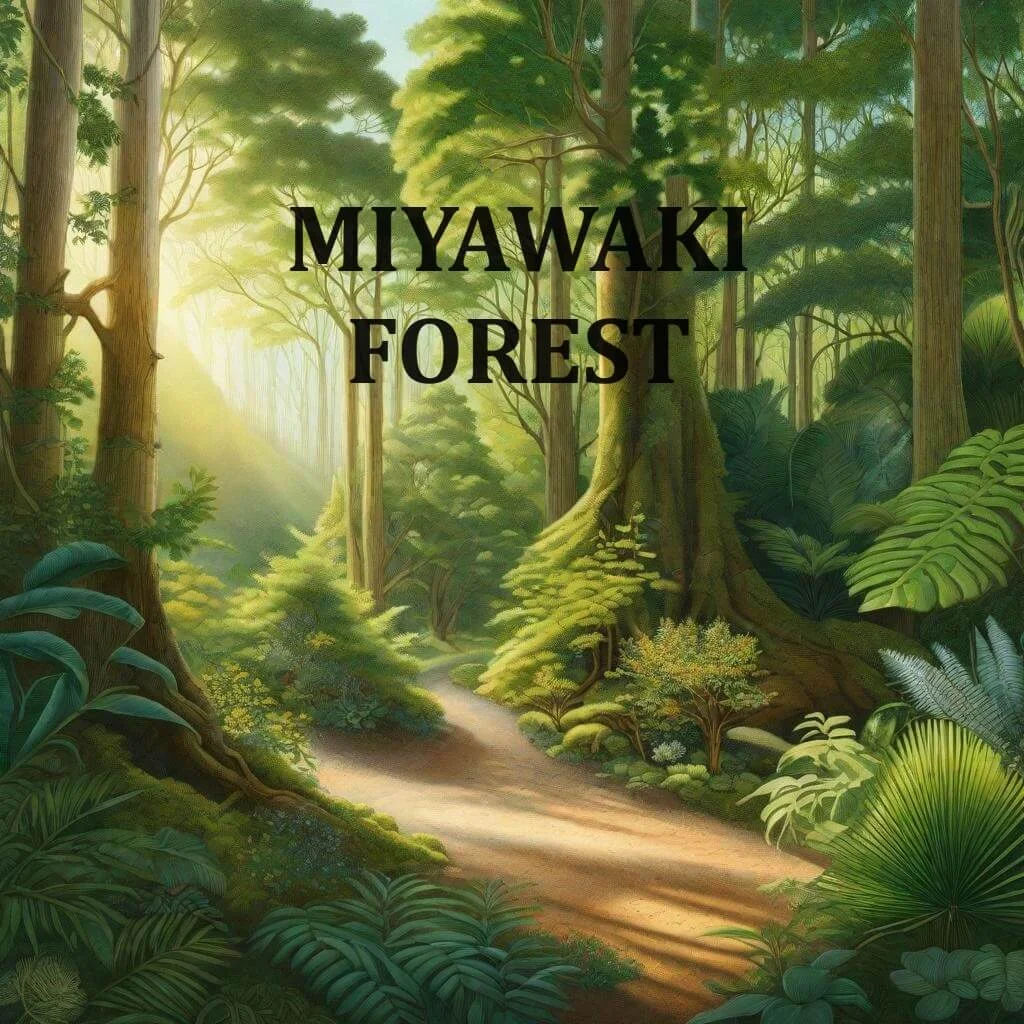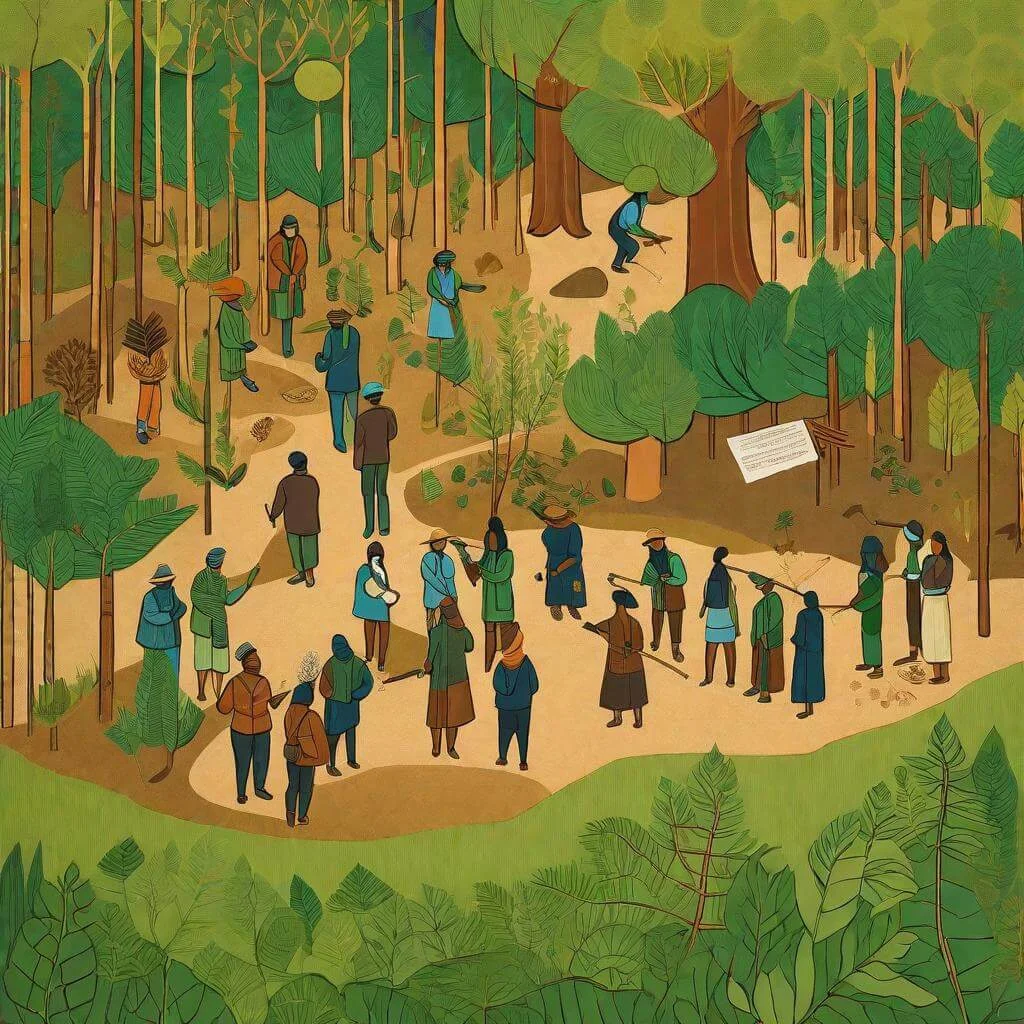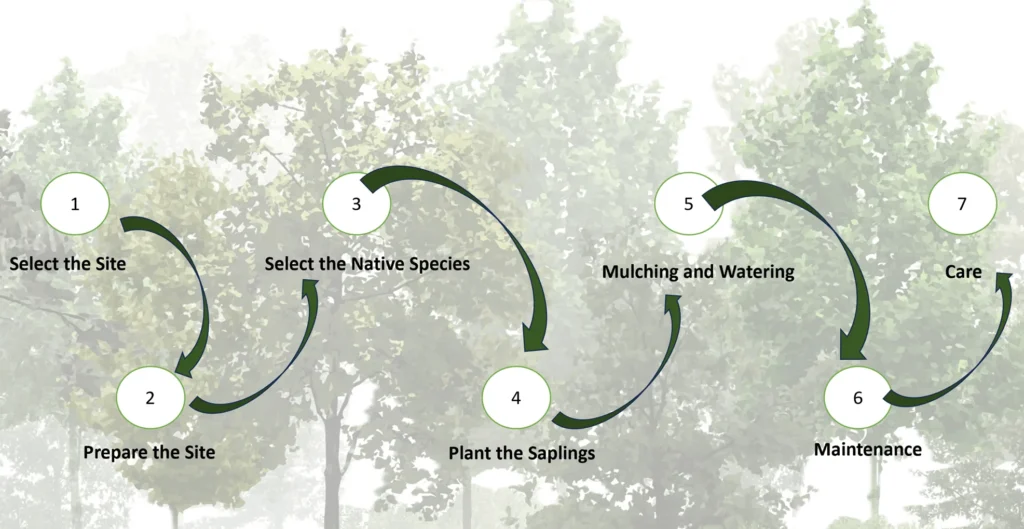
Introduction to Miyawaki Forests
Understanding the Miyawaki Method
The Miyawaki Forest technique, developed by Japanese botanist Akira Miyawaki, is a groundbreaking approach to ecological restoration. This method focuses on creating densely packed, native forests that grow rapidly and mimic natural forests in terms of structure and composition. Miyawaki forests have gained global recognition for their ability to restore degraded ecosystems and combat the adverse effects of deforestation.
Origins and Ideology behind the Miyawaki Forest Technique
Dr. Akira Miyawaki‘s deep concern regarding the rate at which natural forests are disappearing leading to a decline in biodiversity led to the development of the Miyawaki Forest method. With an understanding of the relationships between plants and their environment Dr. Miyawaki embarked on a mission to establish an effective technique, for the rapid and successful restoration of these damaged ecosystems.
Main Principles of the Miyawaki Method
The Miyawaki Forest technique is grounded in several fundamental principles. Firstly, the forests created using this method are entirely composed of native species, ensuring the restoration of natural biodiversity and the promotion of indigenous flora. Secondly, Miyawaki forests are densely packed to accelerate growth and prevent the invasion of exotic and invasive species. Lastly, the technique emphasizes creating multi-layered forests that closely resemble natural forests, allowing for the reestablishment of complex ecological interactions.
Global Recognition and Success Stories of Miyawaki Forests
The success of Miyawaki forests has garnered global recognition, with numerous projects worldwide showcasing their effectiveness. In India a vacant plot measuring 600 meters in the city of Coimbatore was transformed into a flourishing forest within a span of two years through afforestation efforts. This remarkable achievement is not limited to India as other countries such, as Malaysia, Brazil and Germany have also witnessed successes, with the Miyawaki Forest technique. This clearly demonstrates the effectiveness and practicality of this approach.
Environmental Challenges and the Need for Miyawaki Forests
Declining Biodiversity and Deforestation
The planet Earth is going through a decrease in biodiversity mainly caused by deforestation and the destruction of habitats. This loss of living spaces has ranging effects as it disrupts crucial ecosystems, puts species at risk of extinction and negatively affects the lives of humans who rely on these ecosystems for their livelihoods. The Miyawaki Forest technique offers a solution to combat this pressing environmental challenge by restoring native forests and reintroducing diverse plant and animal species.
Climate Change Impact on Ecosystems
Climate change presents another pressing environmental challenge that significantly impacts ecosystems worldwide. The changing climate, with its rising temperatures shifting rainfall patterns and frequent extreme weather events has an effect on the delicate equilibrium of ecosystems. This leads to a loss of biodiversity. Miyawaki forests play a role, in mitigating climate change by absorbing carbon dioxide lessening the impact of greenhouse gas emissions and boosting the resilience of ecosystems.
Role of Miyawaki Forests in Ecological Restoration
Miyawaki forests play a role, in restoration by recreating the complex network of interactions found in natural ecosystems. These forests, with their vegetation diverse range of species and layered canopy structure offer a habitat, for plants and animals. This enables the restoration of ecosystems. Supports the reestablishment of processes.

Benefits and Significance of Miyawaki Forests
Rapid Ecosystem Rehabilitation
One of the striking features of Miyawaki forests is their ability to restore degraded ecosystems rapidly. Due to their densely packed nature, these forests experience accelerated growth rates, allowing them to reach maturity in a fraction of the time it would take a conventional forest. Miyawaki forests provide a tangible solution for addressing the urgent need to rehabilitate damaged landscapes and revive biodiversity.
Enhanced Carbon Sequestration
In the face of the growing climate crisis, carbon sequestration has become a critical aspect of ecosystem conservation. Miyawaki forests have shown remarkable potential in this regard. The lush greenery, abundant plant life and growing nature of these forests make them highly effective, at absorbing and retaining carbon dioxide from the air. Research has actually demonstrated that Miyawaki forests can trap and store, up to 40 times carbon compared to methods of forestation.
Improved Urban Resilience and Livability
The establishment of Miyawaki forests in urban areas brings numerous benefits to both humans and the environment. These urban forests play a role, in making cities more resilient, by mitigating the effects of heatwaves enhancing air quality and minimizing noise pollution. Moreover, they offer city residents the opportunity to connect with nature, which positively impacts their well-being and creates a sense of community. The implementation of Miyawaki forests in cities has the potential to transform concrete jungles into vibrant, sustainable urban environments.
Understanding Miyawaki Forest Ecosystems
Primary Species Selection in Miyawaki Forests
When establishing a Miyawaki forest it is crucial to choose the types of trees. Native species are preferred over ones because they have evolved alongside the environment and are better suited, to the specific conditions of the area. The significance of having a variety of species is highlighted, as it strengthens the resilience of the ecosystem and encourages a harmonious natural community. Furthermore, the Miyawaki Forest method places importance on preserving rare species, which contributes to broader efforts, in conserving biodiversity.
Microclimate Design and Soil Restoration Techniques
The microclimate design in Miyawaki forests involves various strategies to create optimal conditions for plant growth. Trees are carefully arranged to create light and shade patterns that mimic natural forests, allowing different species to thrive in their preferred light conditions. Soil restoration techniques are also essential, as degraded soils need to be revitalized to provide plants with the necessary nutrients. Soil preparation typically involves nutrient enhancement through the addition of organic matter and the use of natural fertilizers.
Natural Succession and Growth Patterns in Miyawaki Forests
Miyawaki forests undergo a progression of ecological development characterized by natural succession and growth patterns. Pioneer species, which are the first to colonize the barren area, help initiate the process. They pave the way for a diverse range of other plant species to establish and grow. Facilitation and competition among different vegetation types drive the evolution of the forest, leading to the formation of distinct growth stages. These stages encompass the emergence of a dense and complex forest ecosystem, closely resembling a natural forest.
Growth Stages of Miyawaki forest
The Miyawaki method is known for its rapid growth and aims to accelerate the development of a forest in a short period compared to traditional reforestation methods. Here are the general growth stages of a Miyawaki forest:
- Initial Stage (0-1 year):
- During the first few months after planting, the focus is on establishing the sapling’s roots.
- Initially, the growth might seem slow as the plants focus on root development rather than above-ground growth.
- Regular watering, weeding, and care are crucial during this phase to ensure healthy root establishment.
- Establishment Stage (1-3 years):
- Within the first year or two, the saplings start to grow rapidly, taking advantage of the densely planted environment and competing for sunlight.
- Vertical growth becomes more noticeable as the trees and plants aim to reach for light.
- The forest begins to develop a layered structure, with taller trees, shrubs, and ground covers occupying different vertical levels.
- Dense Vegetation Stage (3-5 years):
- By the third year or beyond, the Miyawaki forest typically becomes denser and more self-sustaining.
- Plants grow vigorously, and the forest starts resembling a mature ecosystem, with a canopy, understory, and ground cover.
- Biodiversity increases as various species grow and create a balanced ecological system.
- Mature Stage (5+ years):
- As the Miyawaki forest grows older the plants establish themselves. Thrive without support.
- This flourishing ecosystem continually develops, providing a home to a variety of plants and animals.
- Maintenance requirements may reduce as the ecosystem becomes more balanced and self-regulating.
These stages can vary based on various factors, including climate, soil conditions, species selection, and maintenance. Regular monitoring and care are essential throughout the stages to ensure the healthy development of the Miyawaki forest. It’s important to note that while the Miyawaki method accelerates the growth of forests, it may take several years for the ecosystem to fully mature and resemble a natural forest environment.
Layers of Miyawaki Forest
The approach known as the Miyawaki forest technique encourages the establishment of forests, with layers resembling natural ecosystems. These forests boast levels of plant life each contributing significantly to the preservation of biodiversity, nutrient circulation and the general well-being of the ecosystem. The layers typically found in a Miyawaki forest include:
- Canopy Trees: Canopy trees are the towering giants of the forest that form the uppermost layer of vegetation. They are characterized by their height, often reaching significant altitudes and possessing expansive foliage that forms a dense, continuous canopy. These trees provide shade and shelter to the layers beneath them. In a Miyawaki forest, canopy trees might include species like oak, maple, chestnut, or other tall, broad-leaved trees indigenous to the area.
- Trees Layer: The layer below the canopy layer of the forest, known as the understory, is made up of trees that don’t reach the height as the larger canopy trees. Despite their stature these trees play a role, in maintaining the forest’s structure and biodiversity. They are typically strong and adaptable providing support to the ecosystem. Species in this layer might include beech, cherry, or birch, depending on the region and local ecology.
- Sub-Trees Layer: Below the trees layer lies the sub-trees layer, which comprises smaller woody plants that don’t reach the height of the trees but contribute to the density and diversity of the forest. These plants often have multiple stems and branches, offering a varied habitat for wildlife and helping maintain the ecological balance. Examples of sub-trees in a Miyawaki forest could be dogwoods, witch hazels, or elderberries.
- Shrubs Layer: At the bottommost layer is the shrubs layer, consisting of low-growing, often bushy plants. Shrubs play a crucial role in providing ground cover, preventing soil erosion, and offering habitats for small animals, insects, and birds. They also contribute to nutrient cycling and help maintain the moisture content in the soil. Species like blueberries, huckleberries, or ferns might populate this layer in a Miyawaki forest.

The Miyawaki method focuses on planting a mix of native species in these distinct layers, closely mimicking the structure and biodiversity of natural forests. By implementing this approach, the goal is to speed up the development process and improve the well-being and strength of the ecosystem. The different layers provide habitats, for types of plants and animals encouraging a variety of species and ensuring the forests ability to sustain itself in the future. This approach has gained attention worldwide for its effectiveness in restoring degraded lands and creating thriving, biodiverse forest ecosystems in a relatively short time frame.
Implementing Miyawaki Forests: Best Practices and Case Studies
Selecting and Preparing Miyawaki Afforestation Sites
Choosing suitable locations for Miyawaki afforestation is crucial for project success. It is important to consider factors such, as the quality of the soil the elevation of the area and the availability of water. Conducting soil tests and analyzing the site are steps to comprehend the needs of the location and guarantee that plants will grow optimally. It is also essential to engage local communities in the afforestation process, fostering a sense of ownership and creating a lasting impact.
Strategies for Successful Miyawaki Forest Establishment
Establishing a Miyawaki forest requires appropriate planting techniques for seedlings to ensure their optimal growth and survival. Proper watering and irrigation practices are essential, especially during the initial stages, to promote healthy root development and establishment. Regular weeding and maintenance practices are crucial to mitigate competition from invasive species and promote the growth of desirable native plants.
Global Miyawaki Forest Projects: Inspiring Examples
The success of Miyawaki forests can be witnessed in various international projects that have embraced this innovative approach. Both urban and rural settings have seen the establishment of Miyawaki forests, with remarkable results. Collaborative efforts that involve governments, non-governmental organizations and local communities have played a role in the implementation of these projects. The long term impact and sustainability of Miyawaki forests are evident, in the restoration of landscapes the revival of biodiversity and the creation of thriving spaces.
How can you grow a Miyawaki forest at home?
To establish a Miyawaki forest within your residence it is necessary to adhere to a series of steps that will facilitate the flourishing and evolution of a self-sustaining miniature forest. Below is a guide detailing each step:

- Selecting the Site:
- Choose an area in your garden or backyard that receives sunlight for least a few hours each day.
- Make sure that the area is clear, from weeds, debris or any obstacles.
- Preparing the Soil:
- Loosen the soil in the selected area to a depth of around 1 foot (30 cm).
- Remove any existing grass or plants by digging or using a shovel.
- Add organic matter like compost or manure to improve soil fertility and moisture retention.
- Choosing Native Plant Species:
- Research and select native plant species that are indigenous to your region. Aim for a diverse selection including trees, shrubs, herbs, and ground covers.
- Opt for plants that grow well together and support each other’s growth.
- Planting the Saplings:
- Obtain saplings or young plants of the chosen native species from a local nursery.
- Plant them densely in the selected area. Miyawaki forests are characterized by close planting to promote competition among plants and encourage vertical growth in reach of sunlight.
- Follow spacing guidelines for each species but generally aim for a high density of plants.
- Mulching and Watering:
- Apply a layer of mulch (such as wood chips or dried leaves) around the planted area to retain moisture and suppress weed growth.
- Water the saplings regularly, especially during the initial growth phase, to ensure they establish strong roots.
- Maintenance:
- Regularly weed the area to prevent unwanted plants from competing with the saplings.
- Monitor the growth of the plants and provide support such as staking if needed.
- Prune the plants as necessary to encourage healthy growth.
- Patience and Care:
- Miyawaki forests take time to develop and mature. Be patient and continue to care for the plants regularly.
- Monitor the growth and adapt care practices based on the specific needs of the plants and the local environment.
Remember, creating a Miyawaki forest at home requires dedication, patience, and consistent care to ensure the successful growth of a diverse and dense mini forest. It’s also crucial to select the right native plant species and provide proper care for their healthy development.
Summary and Future Possibilities
Recapitulating the Role and Benefits of Miyawaki Forests
Miyawaki forests play a vital role in ecological restoration and biodiversity conservation. Through the rehabilitation of landscapes these forests play a crucial role, in restoring essential ecosystem services and supporting the survival of indigenous species. Additionally, they make a contribution to mitigating climate change, by storing substantial quantities of carbon dioxide. It is important not to underestimate the socio psychological advantages offered by Miyawaki forests as they enhance the quality of life in areas encourage community involvement and promote overall well-being.
Potential Applications and Scaling Up of Miyawaki Forests
The potential applications of Miyawaki forests are vast and range from urban areas to marginalized regions. By incorporating these forests into city planning, urban areas can transform into resilient, green spaces that improve the quality of life for residents. Reforestation efforts in marginalized regions can benefit from the rapid growth and biodiversity promotion offered by the Miyawaki Forest technique. The inclusion of Miyawaki forests in policy and legislation is crucial to encourage widespread adoption and further increase their impact.
Frequently Asked Questions (FAQs)
How time does it typically take for a Miyawaki Forest to fully mature and develop?
Miyawaki forests are known for their rapid growth rates. Depending on the environment and specific conditions, a Miyawaki forest can reach maturity within 10 to 20 years, much faster than traditional afforestation methods.
Can Miyawaki Forests replace traditional afforestation methods?
While Miyawaki forests offer numerous advantages, they should not be seen as a replacement for traditional afforestation methods. Each method has its own strengths and can be used in conjunction to achieve comprehensive ecological restoration.
Are Miyawaki Forests only suitable for certain climates?
Miyawaki forests have successfully been implemented in a wide range of climates, from tropical to temperate regions. However, adaptations in species selection and microclimate design may be necessary to suit specific environmental conditions.
How can individuals contribute to Miyawaki Forest initiatives?
People can get involved in Miyawaki Forest initiatives by supporting afforestation projects participating in tree planting activities as volunteers or promoting the use of Miyawaki Forest techniques, in their communities. Even small-scale contributions can have an impact, on restoring balance.
Is the Miyawaki Method applicable to large-scale reforestation efforts?
The Miyawaki Method has demonstrated possibilities, for carrying out reforestation on a scale especially when incorporating community participation and collaboration. By expanding the application of this technique and utilizing its advantages we can make advancements in the restoration of ecosystems and the fight, against deforestation.
